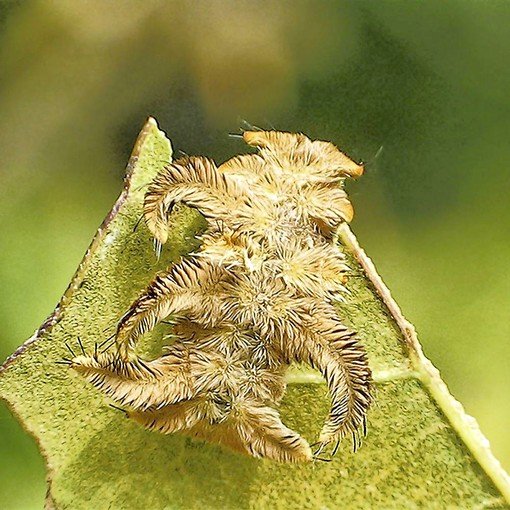Four poisonous caterpillar species are the latest dangerous threat in South Florida.
The venomous caterpillars use their spines to attack by projecting poison at potential enemies.
Of all the unusual species to call south Florida home – from African rats to burmese pythons – these types of caterpillars can cause the worst anguish.
Dr. Jeffrey Bernstein, medical director of the Florida Poison Information Center in Miami, told the Sun-Sentinel newspaper that although the center has not seen any deaths from caterpillar stings, they have gotten hundreds of calls for help with people “out-of-control hysterical”.
“It’s a very painful sting,” Dr. Jeffrey Bernstein told the newspaper.
“We even see people pass out from the pain.”
The four types of caterpillars with the awful venom include the saddleback caterpillar, the puss caterpillar, the io caterpillar and the hag caterpillar.
When they attack humans, the venom can be unbearable, particularly if the saddleback releases its poison.
South Florida resident Michael Stanwyck told the Sun-Sentinel: “It’s like somebody lit you on fire.”
Michael Stanwyck went on to say: “A bee sting times a hundred.”
The species is most threatening around this time of year in Florida as the weather starts to get warmer.
Eggs begin to hatch and the caterpillars grow to become moths.

Some people, although rare, can have an allergic reaction to the toxins and are encouraged to call 911 or go to hospital.
They can experience vomiting, shortness of breath and other reactions.
Others with less severe attacks can be treated at home by calling Poison Control.
Scotch tape can be placed over the wounded area and stripped off over and over again to remove the spines from within the skin.
Although their poison is painful, the caterpillars are not looking to harm anyone or anything. Jaret Daniels, assistant professor of entomology at the University of Florida, told the Sun-Sentinel that they are merely trying to protect themselves.
The venom is used as the caterpillars’ predators, like birds and lizards.
Jaret Daniels said: “If you’re a caterpillar, you have a very challenging life because everything wants to eat you.
“They’re not trying to hurt you. They’re doing it to avoid being eaten.”
Florida has become a popular new home for interesting creatures, including crocodiles that can grow up to 14 feet long.
The reptiles have multiplied 10-fold in the last 40 years in south Florida with about 1,500 crocodiles.
But now they face a new challenge in the area because most of the places they used to call home are now inhabited by humans.
Humans in Florida also have to worry about huge pythons that are wiping out the state’s mammal populations.
A burgeoning population of Burmese pythons – many of them pets that were turned loose by their owners when they got too big – appears to be wiping out large numbers of raccoons, opossums, bobcats and other mammals in the Everglades, according to a study from the Proceeding of the National Academy of Sciences.
The study found that sightings of medium-size mammals are down dramatically – as much as 99%, in some cases – in areas where pythons and other large, non-native constrictor snakes are known to be lurking.
Scientists fear the pythons could disrupt the food chain and upset the Everglades’ environmental balance in ways difficult to predict.
Another species that has threatened the state’s environment are giant Gambian pouch rats that have been found on Florida’s Grassy Key despite concerted efforts by conservation officials to eradicate them.
Officials worry that the voracious rats, which grow to nine pounds, might wipe out some crops and upset the delicate ecological balance if they manage to reach the Florida mainland.
Officials worry that the voracious rats, which grow to nine pounds, might wipe out some crops and upset the delicate ecological balance if they manage to reach the Florida mainland.
The Gambian rat first appeared on Grassy Key in 1999 after eight rats escaped from a local exotic pets breeder.
“We thought we had them whipped as of 2009,” Scott Hardin, exotic-species coordinator for the Fish and Wildlife Conservation Commission, told keysnet.com.
“In the early part of 2011, a resident e-mailed me and said he saw one of the rats. We were skeptical but went back and talked to people and [saw] there were rats that we missed,” Scott Hardin added.
After four female rats were found in 2011, officials unsuccessfully launched another effort to kill them in November and December, primarily through the use of poison-laced cantaloupe and peanut butter.
And it might become difficult to control crocodiles’ interaction with humans if that population continues to grow.
Crocodiles tend to stick to an area they decided they will live in now matter how much they have moved.
So even if they leave a particular spot they chose as their own for weeks and travel far away, they are likely to return.
They will likely continue to be one of the many species like boa constrictors, Nile monitor lizards, vervet monkeys and more to join the state – and wreak havoc on local animal species.
